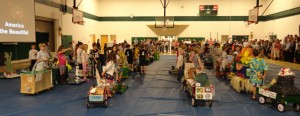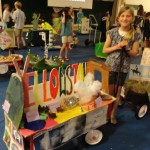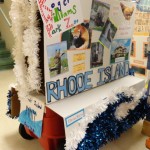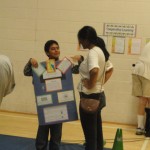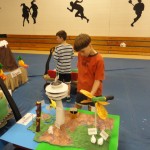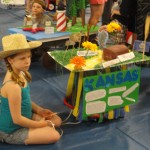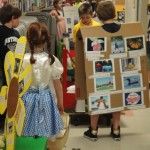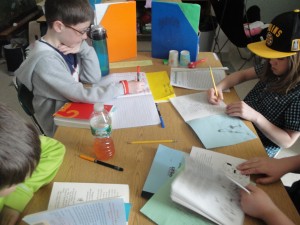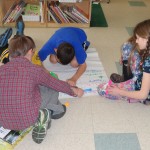Our weeks are full and fast paced. Sometimes I wonder if we are moving too quickly. We have high expectations for our eight and nine year olds and the new Common Core State Standards are asking more.
Math Explorations
 In math the new standards tell us they should have a full understanding addition, subtraction and multiplication and have mastered the facts. They should also understand how to name and add fractions. We are continuing our work with multiplication and basic facts, working to use efficient strategies for problem solving, and learning more about fractions. We can’t thank you enough for all the work you are doing at home to help the children practice and learn their facts. This week the children had up to 15 minutes to complete the 70 problems. This was something we had done when we first did the test and so they will be able to compare this score with their first. They have grown quite a bit. We’ll have one more 6-minute check and then we’ll be done with the weekly tests. Our hope is that the children will continue to practice and grow toward mastery and use.
In math the new standards tell us they should have a full understanding addition, subtraction and multiplication and have mastered the facts. They should also understand how to name and add fractions. We are continuing our work with multiplication and basic facts, working to use efficient strategies for problem solving, and learning more about fractions. We can’t thank you enough for all the work you are doing at home to help the children practice and learn their facts. This week the children had up to 15 minutes to complete the 70 problems. This was something we had done when we first did the test and so they will be able to compare this score with their first. They have grown quite a bit. We’ll have one more 6-minute check and then we’ll be done with the weekly tests. Our hope is that the children will continue to practice and grow toward mastery and use.
It is clear that children who know their facts are able to work more efficiently in all problem- solving situations. Rather than using repeated addition they are multiplying. They know how place value affects the products and are able to employ the standard algorithm easily because they know how the amounts compare and are related. I do see that children who rely on counting for basic sums and products do so with larger amounts as well. Larger amounts mean more counting and greater opportunity for error.
This week many of the problem-solving choices have involved addition and subtraction. I wanted to see what strategies the children would use after a time when they hadn’t been practicing that skill daily. Some went back to drawing, many used expanded notation, some used number lines – but some did choose to use regrouping and trading strategies. Many of the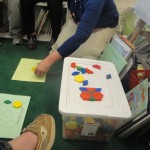 daily problems have also required the children to deal fractions. They are coming to understand how fractions work in different situations. Fair shares are our key and it seems as if most of the children have grasped that concept. This week we used pattern blocks to build and label fractions. With pattern blocks one hexagon is equivalent to two trapezoids, three rhombuses or six triangles. We found all the combinations, played a game where dice determined the numerator and the denominator (not all rolls worked) and created designs with them to show understanding of ½, 1/3, and ¼.
daily problems have also required the children to deal fractions. They are coming to understand how fractions work in different situations. Fair shares are our key and it seems as if most of the children have grasped that concept. This week we used pattern blocks to build and label fractions. With pattern blocks one hexagon is equivalent to two trapezoids, three rhombuses or six triangles. We found all the combinations, played a game where dice determined the numerator and the denominator (not all rolls worked) and created designs with them to show understanding of ½, 1/3, and ¼.
Writing Well
The Common Core State Standards expect that third graders will be able to write cohesive narrative, informative and persuasive pieces of writing. These pieces must be organized and of an appropriate length that they easily achieve their purpose. That’s what we have been working on this week – organization and length. The children are using the ideas we have been exploring about sentences. It can be challenging to think of all aspects of writing while you are in the act. The children have chosen to put a reminder on our daily schedule about the seven aspects of writing they need to consider when working to create a quality piece. Those seven things are: ideas, organization, word choice, sentence fluency, voice, conventions (rules) and presentation.
 We have continued to explore sentences – types and structures. We have been looking for stellar examples as we read together during both the shared reading and chapter read-aloud portions of our day. This week we used a “spider map” to identify sub-topics and details within the main topic of our research. The children organized their research around these categories and tried to write a paragraph for each, with the ultimate goal being at least two full pages. We had just over a 50% success rate for a variety of reasons. Some of the children need to learn to think more about what they read so the impression and understandings are deep enough to stay with them to later be shared. Some of the children need practice writing as long as they can – the craft of putting words together doesn’t come easily to them. Still others need to spend more time writing and less time chatting. It is always a balance and always a challenge to make the choice that will allow you to be most successful. We are growing and learning and find ways to share all we know.
We have continued to explore sentences – types and structures. We have been looking for stellar examples as we read together during both the shared reading and chapter read-aloud portions of our day. This week we used a “spider map” to identify sub-topics and details within the main topic of our research. The children organized their research around these categories and tried to write a paragraph for each, with the ultimate goal being at least two full pages. We had just over a 50% success rate for a variety of reasons. Some of the children need to learn to think more about what they read so the impression and understandings are deep enough to stay with them to later be shared. Some of the children need practice writing as long as they can – the craft of putting words together doesn’t come easily to them. Still others need to spend more time writing and less time chatting. It is always a balance and always a challenge to make the choice that will allow you to be most successful. We are growing and learning and find ways to share all we know.
Choices – Big and Small
SEL – Knowing Yourself Well – Knowing Others and Showing Empathy
Our discussions continue regarding choices and how they are important to us individually and to us as a group. How can we compete at recess, but do it so it feels fun and fair to all? How can we share a joke and then move back to the work that needs to be done? How can we share our excitement for what we are learning without distracting our tablemates from their learning as well? It is a delicate balance and I think you would be proud to see how your children are working to do their best each day.
Bits and Pieces –
- We are halfway through The Secret of Zoom by Lynne Jonell. You might want to ask you child how he or she feels
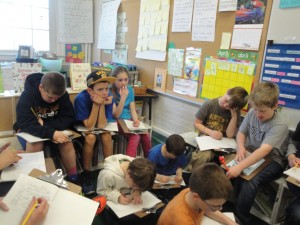 about Lenny Loomski and why. Hopefully they’ll be able to sight examples from the story to explain the kinds of things he does to justify their feelings.
about Lenny Loomski and why. Hopefully they’ll be able to sight examples from the story to explain the kinds of things he does to justify their feelings.
- We have begun an exploration of habitats. The children are working in Naturalist Teams to explore the web of connections found in different parts of the world. Perhaps you’ve heard some new songs at home.
- The children are moving into the final phases of the independent research work. The museum deadline is coming up quickly. We hope you will be able to join us on Tuesday, April 30 from 6:15 to 7:15 pm.
- Please be on the lookout for information about our exciting Grade 3 Parade of the States Project. The culminating event will be on June 12 approximately from 4:45 to 6:15. We have not yet finalized the details but will send them along as soon as we can.
